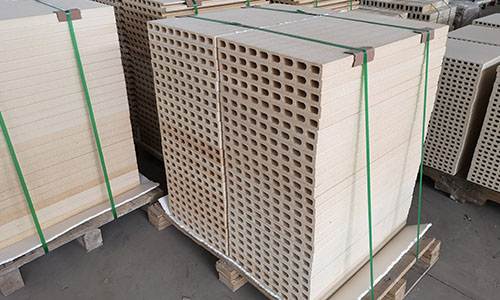

Coordinate is the special grade raw material fro the production of high performance thermal shock resistant refractory products, with the addition of coordinate(MgO:13.8%、Al2O3:34.8%、SiO2:51.4%), its content will be high in the final products. Coordinate refractories have high mechanical strength, low thermal expansion coefficient, its modulus of rupture is as high as 95Mpa, linear expansion coefficient is about 2.0×10-6℃-1 between 20~800℃. Coordinate bricks are mainly used as refractory slab, regenerator slab, base plate, porous plate, push plate, supporting bricks and so on. High thermal shock resistant coordinate refractories are usually produced by α-Al2O3 talc, Suzhou clay, while regular thermal shock resistant coordinate bricks are made by talc, chamotte and bauxite.
Mullite is the generally name of aluminum silicate series minerals. Mullite is a chemically stable binary compound of Al2O3-SiO2 series compounds. Except for mullite (3Al2O3·2SiO2) phase, mullite refractories with lower Al2O3 content also have a little amount of glass phase and cristobalite, those with higher alumina content also have a little corundum phase.
What is coordinate mullite brick?
Coordinate mullite brick adopts sintered mullite, andalusite, tabular corundum and coordinate as main raw material, added with ultra micro powder to reinforce the matrix. The processing procedures of coordinate mullite bricks are mixing, molding, drying and sintering, As the sintering temperature zone of coordinate is very sharp, sintering temperature control is the key factor for its quality. Mullite coordinate bricks produced by this craft not only have excellent thermal shock resistance(after 100 times of 1100℃ water cooling test, there is no crack), but also have excellent high temperature performances( refractoriness under load is higher than 1500℃). Mullite coordinate bricks are popularly used in ceramic industry such as kiln vehicle surface, porous push plate, roller kiln gasket, sagger and so on, as well as the ceramic combustor of hot blast furnaces.
The raw material composition of thermal shock resistant coordinate mullite bricks is between Al2O3-MgO-SiO2 ternary series cinoenstatite and coordinate, the sintering range is very narrow. The raw material consisted of Kaolin and 10~30% of talc has a sintering scope of 90~240℃. When talc content is 40%~70%, the sintering scope drastically drop to 10~30℃. The green body composed of 30%~40% talc, 30~40% of plastic clay and about 20% of calcined Al2O3 can produce porous refractory products with excellent thermal shock resistance. When sintered at 1380℃~1410℃, products with 60% of coordinate can be obtained. To get as much coordinate as possible, and to avoid coordinate discomposing into mullite and glass phase during high temperature sintering, raw material can be proportionally mixed, molded and sintered at 1350℃ to pre-synthesize coordinate, and then grinded to powder, molded again, and finally sintered at 1400℃. The produced coordinate bricks have a expansion coefficient of 1.4×10-6℃-1.
Coordinate mullite bricks have good thermal shock resistance, small thermal expansion coefficient. Between 20~100℃, the linear expansion coefficient of porous coordinate products is only (1~1.2)×10-6·℃-1, at 20~200℃, the linear expansion coefficient is(1~1.5)×10-6℃-1, while it is 2.0×10-6℃-1 between 20~800℃. Since the forming temperature range of coordinate is very narrow, under burned products don’t have enough coordinate, while over burnt coordinate decomposes into mullite and glass phase again. So, adopting high alumina coordinate mullite based raw materials can not only enlarge coordinate forming temperature range, but also avoid coordinate decomposition in high temperature, as well as the enhancement of quality.
Coordinate mullite bricks have better performance than fireclay coordinate products. According to the forming properties of coordinate, sintering temperature should not raise too quickly at the range of 900~1200℃, so crystal water can be evaporated and talc can be better decomposed. Coordinate is formed at 1200~1300℃, so the sintering time at this temperature should be promised to obtain more coordinate, temperature ascending speed should be slow and stable at this temperature zone.
